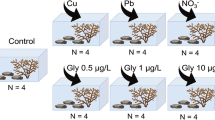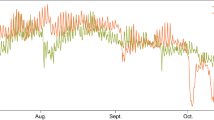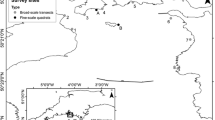Abstract
The effects of environmental changes on species distribution are generally studied at large geographical scales. However, aggregations of individuals can significantly moderate the impact of the environment at smaller, organismal scales. We focused on the intertidal macroalga Fucus guiryi and carried out field and laboratory common garden experiments to evaluate how the different individual morphologies and canopy densities typical of central and peripheral populations modify microhabitat conditions and associated levels of stress. We show that F. guiryi canopies significantly alter environmental conditions (i.e., temperature, humidity and light regimes) and mitigate the levels of stress experienced by individuals within the group. Southern algae are more branched and form denser canopies but, unexpectedly, despite these considerable differences, the mitigating effects of northern and southern canopies did not differ significantly. Microhabitat conditions beneath canopies were more stressful at marginal locations, indicating that southern populations are not more effective than northern algae at mitigating the harsher climate at the edge of the species distribution. Our findings highlight the importance of assessing structural changes in aggregating species across their distribution and relating these to local climates to understand the impact of environmental changes at scales relevant to individual organisms.






Similar content being viewed by others
References
Acker JG, Leptoukh G (2007) Online analysis enhances use of NASA earth science data. Eos 88:14–17
Anderson MJ (2001) A new method for non-parametric multivariate analysis of variance. Austral Ecology 26:32–46
Assis J, Serrão EA, Claro B, Perrin C, Pearson GA (2014) Climate-driven range shifts explain the distribution of extant gene pools and predict future loss of unique lineages in a marine brown alga. Mol Ecol 23:2797–2810
Barry JP, Baxter CH, Sagarin RD, Gilman SE (1995) Climate-related, long-term faunal changes in a California rocky intertidal community. Science 267:672–675
Batters EAL (1902) A catalogue of the British marine algae. J Bot 40:1–107
Bell EC (1995) Environmental and morphological influences on thallus temperature and desiccation of the intertidal alga Mastocarpus papillatus Kützing. J Exp Mar Biol Ecol 191:29–55
Benedetti-Cecchi L (2001) Variability in abundance of algae and invertebrates at different spatial scales on rocky sea shores. Mar Ecol Prog Ser 215:79–92
Bertness MD, Leonard GH (1997) The role of positive interactions in communities: lessons from intertidal habitats. Ecology 78:1976–1989
Brawley SH, Johnson LE (1991) Survival of fucoid embryos in the intertidal zone depends upon developmental stage and microhabitat. J Phycol 27:179–186
Brown JH, Mehlman DH, Stevens GC (1995) Spatial variation in abundance. Ecology 76:2028–2043
Büchel C, Wilhelm C (1993) In vivo analysis of slow chlorophyll fluorescence induction kinetics in algae: progress, problems and perspectives. J Photochem 58:137–148
Bulleri F, Benedetti-Cecchi L, Acunto S, Cinelli F, Hawkins SJ (2002) The influence of canopy algae on vertical patterns of distribution of low-shore assemblages on rocky coasts in the northwest Mediterranean. J Exp Mar Biol Ecol 267:89–106
Cole VJ, McQuaid CD (2010) Bioengineers and their associated fauna respond differently to the effects of biogeography and upwelling. Ecology 91:3549–3562
Cole VJ, McQuaid CD (2011) Broad-scale spatial factors outweigh the influence of habitat structure on the fauna associated with a bioengineer. Mar Ecol Prog Ser 442:101–109
Crain CM, Bertness MD (2006) Ecosystem engineering across environmental gradients: implications for conservation and management. Bioscience 56:211–218
Davison IR, Pearson GA (1996) Stress tolerance in intertidal seaweeds. J Phycol 32:197–211
Dawkins R (1982) The extended phenotype: the long reach of the gene. Oxford University Press
Duarte L, Rossi F, Docal C, Viejo RM (2015) Effects of alga Fucus Serratus decline on benthic assemblages and trophic linkages at its retreating southern range edge. Mar Ecol Prog Ser 527:87–103
Guo Q, Taper M, Schoenberger M, Brandle J (2005) Spatial-temporal population dynamics across species range: from centre to margin. Oikos 108:47–57
Hampe A, Petit RJ (2005) Conserving biodiversity under climate change: the rear edge matters. Ecol Lett 8:461–467
Harley CD, Helmuth B (2003) Local-and regional-scale effects of wave exposure, thermal stress, and absolute versus effective shore level on patterns of intertidal zonation. Limnol Oceanogr 48:1498–1508
Harley CDG, Randall Hughes A, Hultgren KM, Miner BG, Sorte CJB, Thornber CS, Rodriguez LF, Tomanek L, Williams SL (2006) The impacts of climate change in coastal marine systems. Ecol Lett 9:228–241
Hawkins S, Sugden H, Mieszkowska N, Moore P, Poloczanska E, Leaper R, Herbert R, Genner M, Moschella P, Thompson R, Jenkins S, Southward A, Burrows M (2009) Consequences of climate-driven biodiversity changes for ecosystem functioning of north European rocky shores. Mar Ecol Prog Ser 396:245–259
Helmuth B, Harley CD, Halpin PM, O'Donnell M, Hofmann GE, Blanchette CA (2002) Climate change and latitudinal patterns of intertidal thermal stress. Science 298:1015–1017
Helmuth B, Yamane L, Mach K, Chhotray S, Levin P, Woodin S (2008) All climate change is local: understanding and predicting the effects of climate change from an organism’s point of view. Stanford J Law, Sci Policy 2:18–35
IPCC (2007) Climate change 2007: synthesis report. Contribution of working groups I, II, and III to the fourth assessment report of the Intergovernmental Panel on Climate Change
Jorve JP (2008) Ecological consequences of morphological variability in a habitat-forming alga. MSc thesis, San Jose State University, USA
Kordas RL, Harley CDG, O'Connor MI (2011) Community ecology in a warming world: the influence of temperature on interspecific interactions in marine systems. J Exp Mar Biol Ecol 400:218–226
Krause J, Ruxton GD (2002) Living in groups. Oxford University Press, Oxford
Ladah L, Bermudez R, Pearson G, Serrão EA (2003) Fertilization success and recruitment of dioecious and hermaphroditic fucoid seaweeds with contrasting distributions near their southern limit. Mar Ecol Prog Ser 262:173–183
Lamote M, Johnson LE, Lemoine Y (2007) Interspecific differences in the response of juvenile stages to physical stress: fluorometric responses of fucoid embryos to variation in meteorological conditions. J Phycol 43:1164–1176
Lima F, Ribeiro P, Queiroz N, Hawkins S, Santos A (2007) Do distributional shifts of northern and southern species of algae match the warming pattern? Glob Chang Biol 13:2592–2604
Lima FP, Wethey DS (2012) Three decades of high-resolution coastal sea surface temperatures reveal more than warming. Nat Commun 3:704
Lourenço CR, Nicastro KR, Serrão EA, Zardi GI (2012) First record of the brown mussel (Perna perna) from the European Atlantic coast. Mar Biodivers Rec 5:e39
Lourenço CR, Zardi GI, McQuaid CD, Serrao EA, Pearson GA, Jacinto R, Nicastro KR (2016) Upwelling areas as climate change refugia for the distribution and genetic diversity of a marine macroalga. J Biogeogr 43(8):1595–1607
Martínez B, Arenas F, Rubal M, Burgués S, Esteban R, García-Plazaola I, Figueroa FL, Pereira R, Saldaña L, Sousa-Pinto I, Trilla A, Viejo RM (2012) Physical factors driving intertidal macroalgae distribution: physiological stress of a dominant fucoid at its southern limit. Oecologia 170:341–353
Maxwell K, Johnson GN (2000) Chlorophyll fluorescence-a practical guide. J Exp Bot 51:659–668
McQuaid CD, Porri F, Nicastro KR, Zardi GI (2015) Simple, scale-dependent patterns emerge from very complex effects: an example from the intertidal mussels Mytilus galloprovincialis and Perna perna. Oceanogra Mar Biol - Ann Rev 53:127–156
Merilä J, Hendry AP (2014) Climate change, adaptation, and phenotypic plasticity: the problem and the evidence. Evol Appl 7:1–14
Moore P, Hawkins SJ, Thompson RC (2007) Role of biological habitat amelioration in altering the relative responses of congeneric species to climate change. Mar Ecol Prog Ser 334:11–19
Mota CF, Engelen AH, Serrão EA, Pearson GA (2014) Some don't like it hot: microhabitat-dependent thermal and water stresses in a trailing edge population. Funct Ecol 29:640–649
Nicastro KR, Zardi GI, McQuaid CD, Stephens L, Radloff S, Blatch GL (2010) The role of gaping behaviour in habitat partitioning between coexisting intertidal mussels. BMC Ecol 10:17
Nicastro KR, Zardi GI, McQuaid CD, Pearson GA, Serrao EA (2012) Love thy neighbour: group properties of gaping behaviour in mussel aggregations. PLoS One 7(10):e47382
Nicastro KR, Zardi GI, Teixeira S, Neiva J, Serrao EA, Pearson GA (2013) Shift happens: trailing edge contraction associated with recent warming trends threatens a distinct genetic lineage in the marine macroalga Fucus vesiculosus. BMC Biol 11:6
Norton TA (1991) Conflicting constraints on the form of intertidal algae. Eur J Phycol 26:203–218
Parmesan C, Yohe G (2003) A globally coherent fingerprint of climate change impacts across natural systems. Nature 421:37–42
Pearson G, Lago-Leston A, Mota C (2009) Frayed at the edges: selective pressure and adaptive response to abiotic stressors are mismatched in low diversity edge populations. J Ecol 97:450–462
Root TL, Price JT, Hall KR, Schneider SH, Rosenzweig C, Pounds JA (2003) Fingerprints of global warming on wild animals and plants. Nature 421:57–60
Rubal M, Veiga P, Cacabelos E, Moreira J, Sousa-Pinto I (2013) Increasing sea surface temperature and range shifts of intertidal gastropods along the Iberian Peninsula. J Sea Res 77:1–10
Sagarin R, Gaines S (2002) The 'abundant centre' distribution: to what extent is it a biogeographical rule? Ecol Lett 5:137–147
Schiel DR, Lilley SA (2007) Gradients of disturbance to an algal canopy and the modification of an intertidal community. Mar Ecol Prog Ser 339:1–11
Schoenwaelder MEA, Wiencke C, Clayton MN, Glombitza KW (2003) The effect of elevated UV radiation on Fucus spp. (Fucales, Phaeophyta) zygote and embryo development. Plant Biol 5:366–377
Tam JC, Scrosati RA (2011) Mussel and dogwhelk distribution along the north-west Atlantic coast: testing predictions derived from the abundant-centre model. J Biogeogr 38:1536–1545
Ting CS, Owens TG (1993) Photochemical and nonphotochemical fluorescence quenching processes in the diatom Phaeodactylum Tricornutum. Plant Physiol 101:1323–1330
van Hulzen JB, van Soelen J, Bouma TJ (2007) Morphological variation and habitat modification are strongly correlated for the autogenic ecosystem engineer Spartina anglica (common cordgrass). Estuar Coasts 30:3–11
Viejo RM, Martínez B, Arrontes J, Astudillo C, Hernández L (2011) Reproductive patterns in central and marginal populations of a large brown seaweed: drastic changes at the southern range limit. Ecography 34:75–84
Walther G-R, Post E, Convey P, Menzel A, Parmesan C, Beebee TJC, Fromentin J-M, Hoegh Guldberg O, Bairlein F (2002) Ecological responses to recent climate change. Nature 416:389–395
Watt CA, Scrosati RA (2013) Bioengineer effects on understory species richness, diversity, and composition change along an environmental stress gradient: experimental and mensurative evidence. Estuar Coast Shelf Sci 123:10–18
Wahl M, Jormalainen V, Eriksson BK, Coyer JA, Molis M, Schubert H, Dethier M, Karez R, Kruse I, Lenz M, Pearson G, Rohde S, Wikström SA, Olsen JL (2011) Stress ecology in Fucus: abiotic, biotic and genetic interactions. Adv Mar Biol 59:37–105
Wright JP, Jones CG (2006) The concept of organisms as ecosystem engineers ten years on: progress, limitations, and challenges. Bioscience 56:203–209
Zardi GI, Nicastro KR, Canovas F, Costa JF, Serrão EA, Pearson GA (2011) Adaptive traits are maintained on steep selective gradients despite gene flow and hybridization in the intertidal zone. PLoS One 6:e19402
Zardi GI, Nicastro KR, Serrão EA, Jacinto R, Monteiro C, Pearson GA (2015) Closer to the rear edge: ecology and genetic diversity down the core-edge gradient of a marine macroalga. Ecosphere 6:art.23
Acknowledgements
This research was funded by projects UID/Multi/04326/2013 and IF/01413/2014/CP1217/CT0004 from the Fundação para a Ciência e Tecnologia (FCT-MEC, Portugal) and supported by the South African Research Chairs Initiative (SARChI) of the Department of Science and Technology and the National Research Foundation.
Author information
Authors and Affiliations
Corresponding author
Ethics declarations
Conflict of interest
The authors declare that they have no conflicts of interest.
Additional information
Communicated by P. Martinez Arbizu
Electronic supplementary material
ESM 1
(DOCX 41.9 kb)
Rights and permissions
About this article
Cite this article
Monteiro, C., Zardi, G.I., McQuaid, C.D. et al. Canopy microclimate modification in central and marginal populations of a marine macroalga. Mar Biodiv 49, 415–424 (2019). https://doi.org/10.1007/s12526-017-0824-y
Received:
Accepted:
Published:
Issue Date:
DOI: https://doi.org/10.1007/s12526-017-0824-y




